Department of Physics
Wake Forest University

Department of Physics
Wake Forest University
(Source: web)
PHY 337/637: Analytical Mechanics
e-Syllabus
Instructor: Dr. David Carroll
Class Location: 103 Olin Hall
Time: 12:30 - 1:45 T/TH
Ave. Out of Class Prep Time: 2 hours/class
General Office Hours: Tues/Thurs 9:00 - 12:00
214 Olin Physical Laboratory, Reynolda Campus
Office Hours by Appointment Email: carroldl@wfu.edu


Welcome to PHYS 337/637
This course is a detailed introduction to variational methods in mechanics (Lagrangian and Hamiltonian formulations). It is highly theoretical in nature, developing an advanced formalism for dynamics that focuses on underlying symmetries and geometries. Specific reference to applications in astrophysics and cosmology will be made and transitional points to relativity and quantum mechanics will be given. The graduate 639 section is an excellent refresher for those preparing for the graduate qualifier (requires a few additional assignments). This course runs 1/2 a semester and is evaluated midterm (October).
Course Outline
I.
Generalized coordinates, constraints and minimum coordinate sets
Virtual work and Maupertuis'/D’Alembert principles
Derivation of the Lagrangian
The resulting equations of motion
Lagrangian multipliers
Exam 1
II.
Variational Calculus
Hamilton’s Principle
Action Integrals and the Lagrangian
III.
The Hamiltonian
Derivation of Hamilton's equations
Conservation principles
Phase Space and Global Behavior
Hamilton Jacobi
Exam 2
Grades
The Class is made up of Lectures (which will be delivered on T/TH 12:30 to 1:40 with additional explanation and discussion), Weekly Homework, and Sectionals (problem solving sessions). Grading assessments will provide a determination of:

1) the quantity of work done by the student, (30% of grade)
2) the quality of work done by the student, (50% of grade)
3) the ability of the student to use concepts beyond what has already been presented to address unsuspected problems. (20% of grade)
How you get Graded:
10% Showing up to class and recitation, participating in discussions
20% Handing in the homework assignments with reasonable attempts to solve problems
50% Two, in class, quizzes. They are weighted 25% each. The problems will be variations of the homework. Work the HW and understand each problem, you will do well on the quizzes.
20% Challenge problems: take home portion of the quizzes. These problems are a little harder and add an additional 10% to the quiz. Generally, there will be 2 of these on each quiz.
Narrative and Prerequisites
You have learned Newton’s laws and spent quite a bit of time applying them. So this class assumes a working knowledge of:

i.The freebody diagram
ii.Newton’s 3 main laws
iii.Kinetic and potential energy
iv.Collisions
v.*Extended bodies and Euler Angles
vi.Gravitational problems and Orbits
vii.*Harmonic and nonharmonic oscillations
The * topics are often missed, and they will be really important. So we will review these...
The Newtonian approach makes use of the philosophy that abstraction of forces being applied to a body and the body then moving is a result of the forces. To be predictive, we have to be rather detailed about the nature of the forces: contact forces, gravitational forces, centripetal forces, and more. Newton’s laws then provide us with equations that describe a unique space-time path of each object, assuming we know the unique initial conditions of motion.
However in fields such as astrophysics, fluid dynamics, atmospheric science, etc, this can be a very difficult way to solve problems. Moreover, it isn’t very useful in approaching quantum mechanics.

The Text for the course is also quite helpful. “A Student’s Guide to Lagrangians and Hamiltonians” by Patrick Hamill, Cambridge press. You should read this each night and be familiar with the examples.